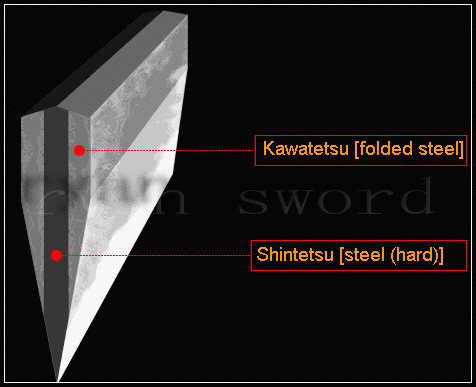Introduction
A Japanese sword is truly a work of art in steel. It is functional, beautifully crafted, and extremely durable. Even today the craftsmen still use the traditional methods of forging and steel preparation, and it works marvelously (Yoshihara and Kapp 8).
In general, the katana is a two-handed samurai sword of the unique and recognizable shape which makes it popular all over the world.
Analysis
When examining a sword, there are three main factors to consider: “its shape, the surface of the steel, and the pattern on the hardened cutting age” (Yoshihara and Kapp 15). When viewing the shape of the sword, pay attention to the degree of tapering from the blade base to the tip, to the blade’s curvature, length, thickness, weight, and balance. The fact is that the katana is considered one of the most perfect sword humanity has ever created. That is why the process of its crafting is comprised of various stages and demands some special materials and sort of steel.
Usually, the preparations required for making a Japanese samurai sword-like katana include melting river sand with a high concentration of iron and charcoal to acquire the type of steel needed for the forging. It is a very ancient procedure that lasts about three days in total. The charcoal is one of the major elements of the Japanese sword blade steel called tamahagane. This type of composite metal usually costs almost fifty times more than any other steel acquired through modern techniques (Chaddha and Resutek par. 2).
This fact also conditions the high price of the final product as katana is one of the most expensive swords nowadays. The average price on the authentic Samurai sword could be from 12000$ to 25000$, but it might vary depending on the steel used and the reputation of the master.
Nevertheless, tamahagane should not reach a molten state before the necessary amount of carbon is dissolved. Once this is done, the material is sent to a swordsmith to remove impurities. This process is the most essential as it saves the future blade from exposure to natural destructors such as corrosion. Only iron and carbon should remain in the composition. The carbon concentration is evaluated by the degree of yielding to pounding.
That is why the forging process is unusual. It includes heating the high-carbon steel and shaping it into a channel resembling an arch. The low-carbon steel is hammered and forged into the high-carbon steel. Together they form the sword’s blade and core. The balance of properties is very important during this process.

In general, the katanas blade consists of two different sorts of still. Picture 1. demonstrates the pattern according to which these sorts are distributed. The combination of folded and hard steel contribute to the acquisition of the unique qualities of the sword which results in the creation of its image.
Concluding, one should note that the sword-forging techniques in Japan are as ancient as the history of a Japanese sword itself. Admittedly, the process has not changed much since ancient times, and nowadays swordsmiths adhere to the same pattern their predecessors used.
Conclusion
Besides, it is also possible to state the fact that the outdated approach also increases costs and result in the great price of every blade. Yet, despite its popular image katana could be compared to many swords made with the usage of new technologies (Clements para. 5). For these reasons, it is possible to recommend to reconsider the approach to the creation of every blade to decrease its cost and improve some other qualities. Additionally, the implementation of innovations might also promote the improvement of some qualities of the blade.
Works Cited
Chaddha, Rima, and Audrey Resutek. Making a Masterpiece. n.d.
Clements, John. Longsword and Katana Considered. n.d.
Yoshihara, Yoshindo, and Leon Kapp. The Art Of The Japanese Sword. Tokyo: Tuttle Pub., 2012. Print.